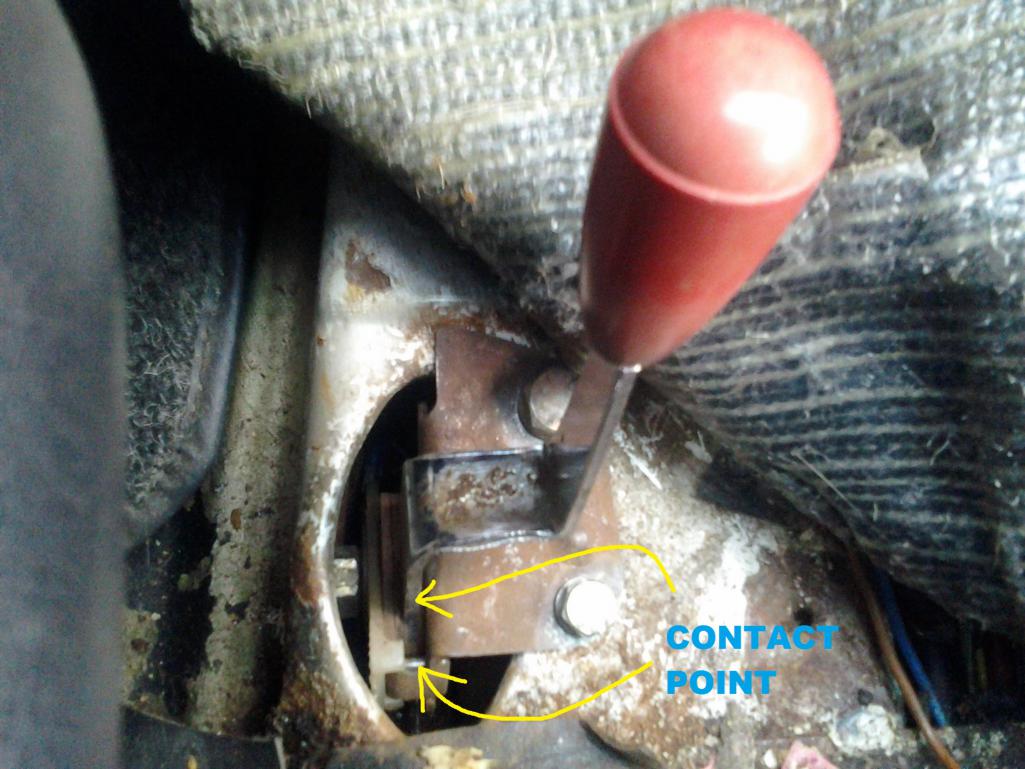Printable Version of Topic
Click here to view this topic in its original format
914World.com _ 914World Garage _ Heater fan lever
Posted by: steuspeed Jan 9 2015, 01:12 PM
So the grounding wire from the relay connects to the plastic part with the contact nub on it. When you pull the lever the nub contacts the lever. the lever is isolated by two plastic discs. Does the ground go through the bolt that holds the whole assembly together? ![]()
Posted by: Dave_Darling Jan 9 2015, 02:24 PM
I think I recall that is how it grounds.
--DD
Posted by: steuspeed Mar 25 2015, 03:53 PM
My heater fan was still intermittent after I took it apart. As near as I can tell, the circuit grounds when these two surfaces make contact. I can see a tiny spark when they touch, and relay 55 switches to run the heater fan. Can anyone confirm this is how it is supposed to work? I polished the surfaces with my dremel wire brush attachment. It seemed to help, but it does not take much movement for it not to work. Any comments, suggestions or help appreciated.
Attached thumbnail(s)
Posted by: theleschyouknow Mar 25 2015, 07:00 PM
can't help with the electrical side
so it's either 1 or 0/on or off, huh? when I get too warm I move the lever halfway down I guess it's only psychosomatically that I feel like this cuts the heat factor in half - isn't the human brain awesome! ![]()
Posted by: steuspeed Mar 25 2015, 07:52 PM
can't help with the electrical side
so it's either 1 or 0/on or off, huh? when I get too warm I move the lever halfway down I guess it's only psychosomatically that I feel like this cuts the heat factor in half - isn't the human brain awesome!
That would be fan off and heat exchange flapper valves half open.
Posted by: Spoke Mar 25 2015, 08:07 PM
My heater fan was still intermittent after I took it apart. As near as I can tell, the circuit grounds when these two surfaces make contact. I can see a tiny spark when they touch, and relay 55 switches to run the heater fan. Can anyone confirm this is how it is supposed to work? I polished the surfaces with my dremel wire brush attachment. It seemed to help, but it does not take much movement for it not to work. Any comments, suggestions or help appreciated.
You are correct with the contact on the handle. I had such a problem that I ended up running an extra wire to complete the circuit. I just couldn't get the handle itself to make the contact.
Posted by: theleschyouknow Mar 25 2015, 08:30 PM
can't help with the electrical side
so it's either 1 or 0/on or off, huh? when I get too warm I move the lever halfway down I guess it's only psychosomatically that I feel like this cuts the heat factor in half - isn't the human brain awesome!
That would be fan off and heat exchange flapper valves half open.
ah so. makes perfect sense now that you explained it to me
Posted by: steuspeed Mar 25 2015, 08:41 PM
My heater fan was still intermittent after I took it apart. As near as I can tell, the circuit grounds when these two surfaces make contact. I can see a tiny spark when they touch, and relay 55 switches to run the heater fan. Can anyone confirm this is how it is supposed to work? I polished the surfaces with my dremel wire brush attachment. It seemed to help, but it does not take much movement for it not to work. Any comments, suggestions or help appreciated.
You are correct with the contact on the handle. I had such a problem that I ended up running an extra wire to complete the circuit. I just couldn't get the handle itself to make the contact.
It's hard to believe this is the circuit design when the nub and swiper plate part make much more sense. You would think there would be another nub contacting another plate as the lever was moved.
Powered by Invision Power Board (http://www.invisionboard.com)
© Invision Power Services (http://www.invisionpower.com)
